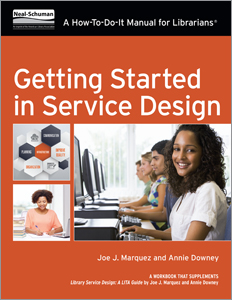Primary tabs
You don't need to be an ALA Member to purchase from the ALA Store, but you'll be asked to create an online account/profile during checkout to proceed. This Web Account is for both Members and non-Members. Note that your ALA Member discount will be applied at the final step of the checkout process.
If you are Tax-Exempt, please verify that your account is currently set up as exempt before placing your order, as our new fulfillment center will need current documentation. Learn how to verify here.
- Description
- Table of Contents
- About the authors
- Reviews
Service design is a holistic, collaborative methodology that puts the user at the center of the service delivery model. Because this approach prioritizes users and their overall experience, it's a valuable framework that librarians and administrators can use as a group to assess, revise, and create library services, spaces, and workflows. In this book, the authors use an action-oriented assortment of exercises, templates, and tools to make service design more accessible to all types of libraries. Escorting readers through all the fundamentals, this how-to-do-it manual
- introduces the service design concept, what it is used for, and how it can benefit every institution;
- includes a checklist for determining if service design is the best approach;
- describes the four necessary phases for any service design project, with key exercises for thinking in service design terms to craft a "thick description" of the library's users and behavior;
- explains the importance of making assessment part of the fabric of the library, and offers tools following through;
- reviews real-life examples of implemented service design, spotlighting how students and researchers use library services;
- provides templates for documenting service design; and
- offers advice for moving forward and managing change.
This book is the perfect primer for those new to the methodology as well as a useful reference to consult throughout a service design project.
Acknowledgments
Chapter 1 About Service Design
Service Design Defined
Why Service Design?
The Phases of Service Design
- Pre-Work
- Observation
- Understanding/Thinking
- Implementation
- Maintenance/Post-Assessment
The Service Design Mindset
- Co-Creating
- Making the Intangible Tangible
- Confirming with Evidence
- Focusing on User Needs and Expectations
- Thinking Holistically
- Having Empathy
- Being Open-Minded and Not a Devil’s Advocate
- Being Willing to Evolve
Reasons for a Service Design Inquiry
Chapter 2 Getting Started with Evaluating Services
Library Service Design Heuristics
Sample Heuristic Evaluation
- Service: Checking out a Book
Conclusion
Further Reading
Chapter 3 Project Planning
Identifying Real Problems
Creating Teams
- Internal Teams
- External Teams
Identifying Stakeholders
Devising Team Rules
- Questions to Consider when Making Ground Rules
Project Definitions
- Project Purpose
- Project Objectives
- Project Scope
Scheduling
Project Documentation
Chapter 4 Service Design Tools
Service Inventory
Ecology Map
Stakeholder Map
Surveys
Space Analysis
Service Safari
Interviews and Contextual Inquiry
- Interview Protocol Checklist
Discussion Groups
Observation
Work Like a User
Scenarios and Expectation Maps
Journaling
Customer Journey Map
Mobile Ethnography
Prototyping
- Nondynamic Service Prototypes
- Dynamic Service Prototypes
Focus Groups
- Focus Group Checklist
- Recruiting Checklist
Graffiti Wall
Blueprinting
Example: Use of Tools in Service Design Projects
- Public Library
- Academic Library
- Space Analysis
- Customer Journey Map
- Mobile Ethnography
- Service Blueprint
Chapter 5 Analysis and Synthesis
Transcribing
Preparing Data for Coding
Coding
Confirmation
Conclusion: The Write-Up
Further Reading
- Appendixes
- Bibliography
- Index
Joe J. Marquez
Joe J. Marquez was an academic librarian for 10 years at Reed College and Sonoma State University. His most recent work was at Nike working with a design team in support of employee experience. He has presented and written on topics related to service design, UX tools, and library space assessment. While not currently a librarian, he remains active in the library community through teaching and outreach and never hesitates to evangelize about service design when asked. He is the co-author of the books Library Service Design: A LITA Guide to Holistic Assessment, Insight, and Improvement (2016) and Getting Started in Service Design (2017). He was awarded the first Future of Librarian Fellowship in 2017 from the ALA Center for the Future of Libraries and was named a 2018 Mover and Shaker by Library Journal. He has an MLIS from the University of Washington iSchool and an MBA from Portland State University.
Annie Downey
Annie Downey is Associate Provost and Director of the Armacost Library and Learning Commons at the University of Redlands in California. She has worked as a social sciences librarian and library administrator in a variety of academic environments for over 15 years, including her most recent roles as the Associate College Librarian and Director of Research Services for the Reed College Library and Head of Research and Instruction Services for the University of North Texas Libraries. She received her PhD in higher education in 2014 and her MLS in 2004 from the University of North Texas. She has written and presented on service design, critical librarianship, information literacy, K¬20 library instruction, assessment, women in libraries, and academic library administration. Annie is the author of Critical Information Literacy: Foundations, Inspiration, and Ideas and the co-author, with Joe Marquez, of Library Service Design: A LITA Guide to Holistic Assessment, Insight, and Improvement and Getting Started in Service Design. She was awarded the first Future of Libraries Fellowship in 2017 from the ALA Center for the Future of Libraries and was named a 2018 Mover and Shaker by Library Journal.
"This is an eminently usable hands-on guide to helping every library be the best it can be."
— VOYA
"Lush with tables, figures, worksheets, and visual prompts, this book will benefit library staff in finding a navigational route in what can be a daunting process ... Highly recommended."
— ARBA
"A useful and practical book ... It is written in a clear and engaging style and includes a short bibliography for further reading."
— Catholic Library World



